
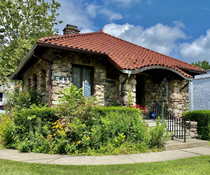
The Woodbury/ Subject Files for — Won't you consider becoming a member of the Historical Society? We can't do our work without your continued support! CLICK HERE to download the Woodbury Historical Society Membership and Donation form. Thank you! — — Woodbury The Gatehouse
|
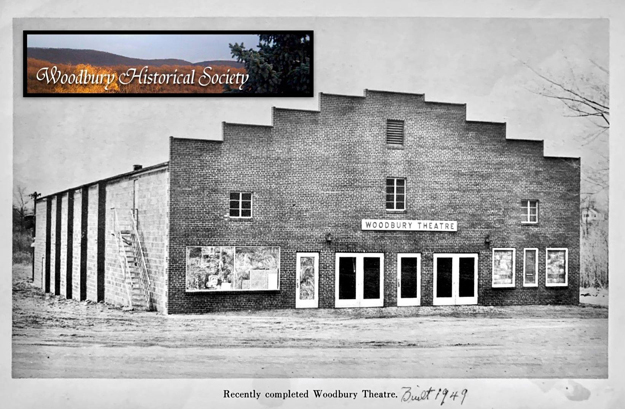
The Woodbury Theatre was once a staple of those visiting the region’s summer bungalow colonies. Built in 1949 at the junction of Ridge and Seven Springs Roads, a vacant lot now occupies its site.
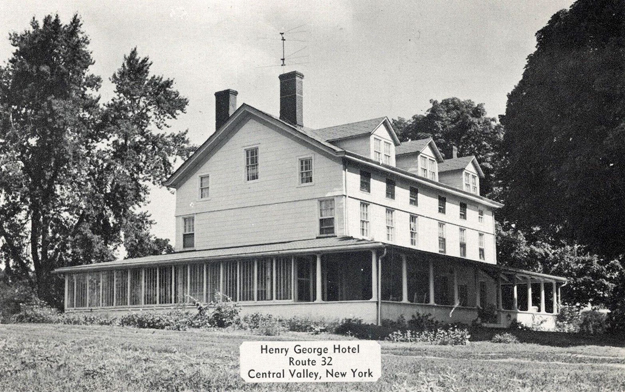
At one time, Woodbury was home to more than twenty different hotels and boarding houses. While most vanished by the 1930s, a few adapted to changing times and survived into the mid-twentieth century. One such example was the Henry George Hotel, located on Route 32 in Central Valley on today’s site of the former Dug Out ice cream stand and America’s Best Value Inn.
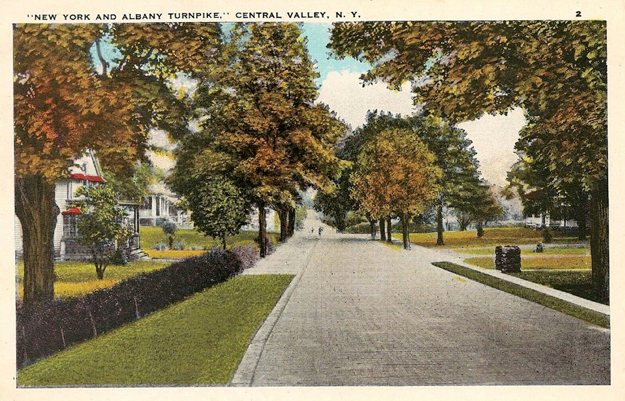
The grand trees lining route 32 in this Central Valley postcard scene almost make it impossible to identify as being in Woodbury. All of the homes on the left side have either been demolished or lost to fire; a new storefront adjacent to Estrada Road now occupies the site. The Howard Gregory home seen on the right side of this image, known more recently as the Kevin J. O’Connor building, still remains today.
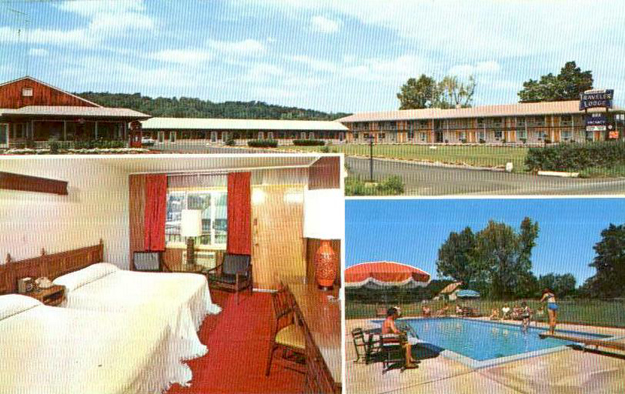
For all of its feverous tourism during the early twentieth century, Woodbury gained few new hotels after 1950. Despite being located well outside the village of Harriman’s borders, the Harriman Traveler Lodge was a more contemporary hotel in Woodbury’s history. Rebranded as America’s Best Value Inn, the business still accommodates guests today visiting the nearby Woodbury Common Premium Outlets.
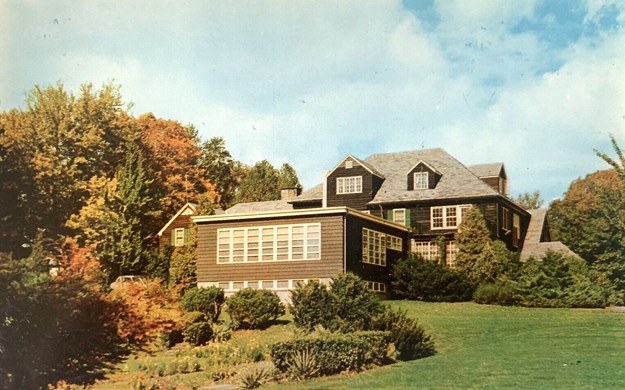
Green Acres was one of Woodbury’s many large estates that was later adapted into a sizable hotel by the 1960s. Complete with a separate structure fitted with between eight to ten guest rooms, the property fell under the ownership of Gasho Japan in Central Valley. Within the last five years, all of the former Green Acres structures were demolished.

The buildings of downtown Highland Mills have changed little from this late 1940s image, save for O’Brien’s Tavern seen at left. Located at the south corner of Route 32 and County Route 105, it burned several decades after this image was taken. The structures identical counterpart across the street, today’s Mario’s Pizzeria, still stands today. The O’Brien’s Tavern lot remains vacant.
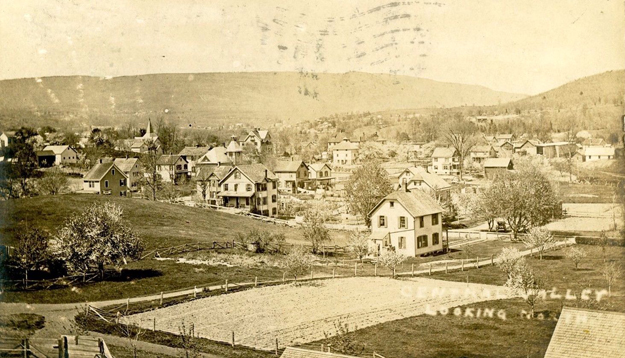
This overview of Central Valley, NY is taken from the ornate silo of the Maplehurst Estate which once covered the area of today’s Dorothy Court, Bauscher Court, Charlotte Court, the Oak Clove Shopping Mall, and the Woodbury Diner. To the left, the Central Valley Methodist Church is visible as is the tower of the original Valley Avenue school at center.

From the collection of WHS member William Cavanagh: In this circa 1908 scene of Highland Mills, George Lamoreaux’s Highland Mills Hotel is on the left. It was succeeded by the Goff Inn which burned down in the 1920s. The newsstand is to the right of the hotel and then the old wooden bandstand—better known today as Victory Park. Note the man walking his dog on the dirt road (Albany Turnpike) and the horse and buggy behind him near the Townsend House—the only structure still standing in this image and now functioning as apartments.
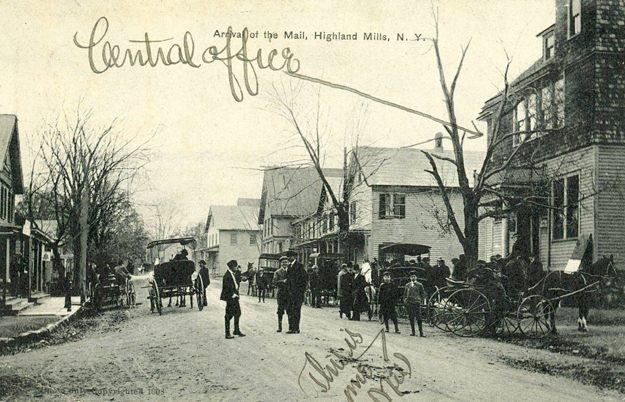
From the collection of WHS member William Cavanagh: This Highland Mills postcard (circa 1909) states "arrival of the mail." Quite a scene in downtown Highland Mills in front of today’s court house. Note how well-dressed everyone looks and the many fancy wagons. The tower viewable on the court house structure has since been removed.
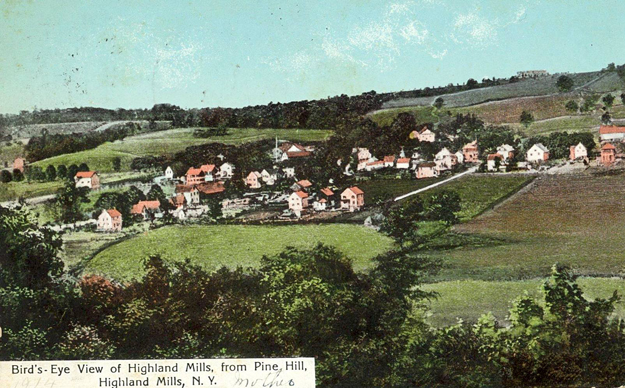
From the collection of WHS member William Cavanagh: This Highland Mills postcard (circa 1914) shows a view of Highland Mills from Pine Hill. At the rear of the image, a seemingly immense structure viewed from atop the hill was Hillcrest Hall, a hotel later converted into the Unser Camp establishment. Today, Highland Lake Estates sits upon its site.
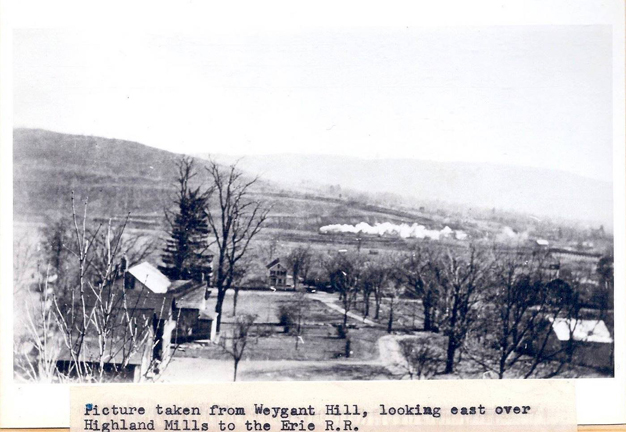
A view from 1916, taken from Weygant Hill Road in Highland Mills, NY. A train on the Erie Railroad's Newburgh Shortcut can be seen in the background, the iconic rock cut completed with the construction of the railroad’s Graham Line between 1906 and 1909 is seen clearly at center and remains today.
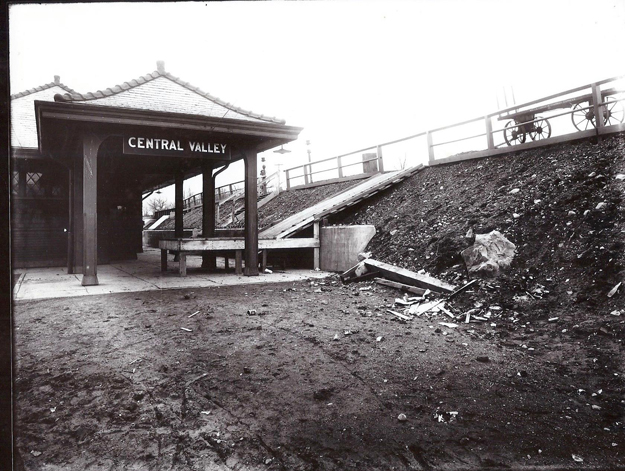
Building the Graham between 1903 and 1906 at Central Valley entailed much construction. This scene shows the present day intersection of Valley Avenue and Smith Clove Road (Main St.) before the station was moved to its present location. The bridge viewed directly below the station sign carries the tracks over Smith Clove Road and remains today.
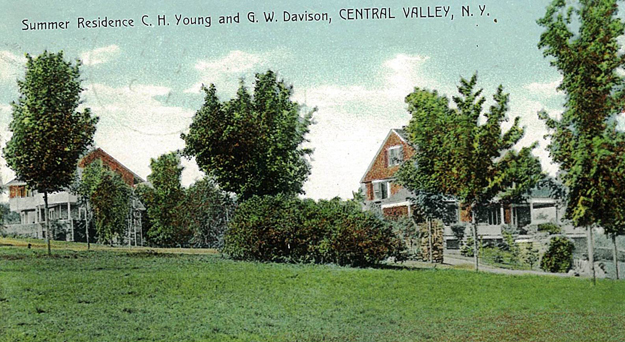
From the collection of WHS member William Cavanagh: This circa 1909 postcard shows two fine homes in Central Valley’s Oak Clove development, one belonging at the time to Charles H. Young (“Edgewood”), the other to George W. Davison ("Hill Holme,” The Fetheroff house). Both names are shown with the labels on Mueller’s 1903 Atlas of Orange County. According to a newspaper clipping in local historian Emma McWhorter's book, the Young house was completed in Dec. 1901 at a cost of $4,000. "The house contains 12 rooms and a bath and is heated with hot air, with piping to every room except the two servant's rooms in the attic. The laundry room is in the basement. The artistic fireplace in the living room is being built by Isaiah Rose." The house was built as a summer cottage for Charles H. Young, a prominent lawyer who lived in New Rochelle and practiced there and in New York City. He had married a local Cornell cousin (Maud Ferguson) and became president of the Land Improvement Company which developed Oak Clove. When he died in 1919, Edward Cornell bought up the rest of the land at auction, which included the property where his children Katherine Stainton, Julien Cornell, and Phebe Maresi built their houses. Interestingly, most of the other Oak Clove homes were occupied by local residents. Perhaps these two homes represented part of an effort to attract "out-of-towners" to the Oak Clove development.
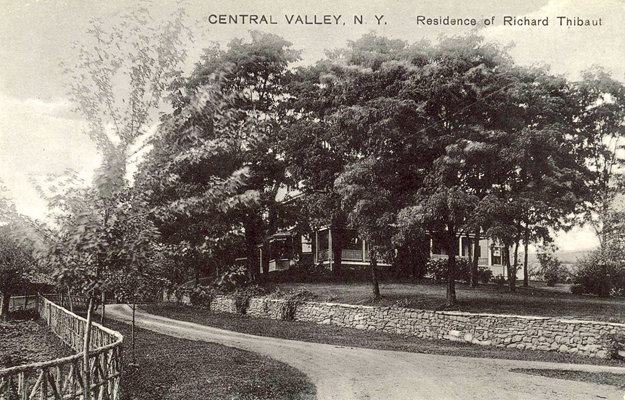
From the collection of WHS member Will Cavanagh: This road is now the driveway for the Niemand house (the big pink house on Route 32 between Central Valley and Highland Mills). Back in the day, and as shown on the 1903 atlas, this was the main road from Route 32 (Albany Turnpike) to Route 208. The lower part of the road that we now know as Roselawn was a private road through the A.H. Taylor Stock Farm and “Roselawn” hotel.
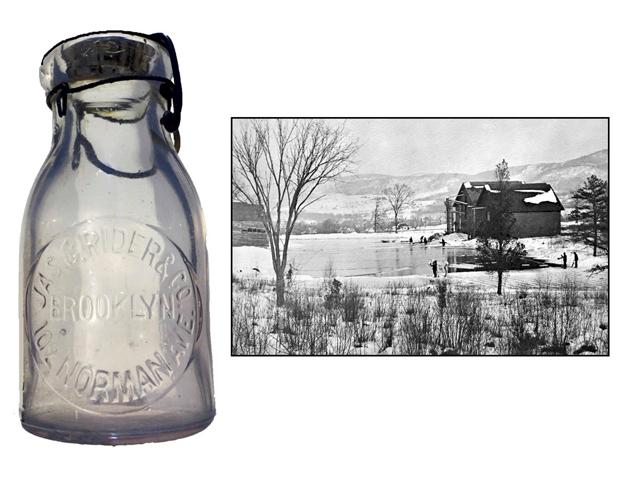 James C. Rider was one of Orange County's numerous milk dealers. While likely owning few cows, dealers like Rider purchased milk from nearby farmers and then shipped it in cans from his creamery in Central Valley, NY to New York City where it would be consigned in glass milk bottles. To keep his milk cool, Rider owned an ice pond just south of the village of Central Valley where ice would be harvested and then placed in railroad cars to refrigerate the milk. His business has been gone for over a century, but the Rider pond still serves visitors today as the refurbished Central Valley Community Pool.
James C. Rider was one of Orange County's numerous milk dealers. While likely owning few cows, dealers like Rider purchased milk from nearby farmers and then shipped it in cans from his creamery in Central Valley, NY to New York City where it would be consigned in glass milk bottles. To keep his milk cool, Rider owned an ice pond just south of the village of Central Valley where ice would be harvested and then placed in railroad cars to refrigerate the milk. His business has been gone for over a century, but the Rider pond still serves visitors today as the refurbished Central Valley Community Pool.

A look at downtown Central Valley with the Erie Railroad's Newburgh Shortcut/Graham Line visible to the right. The station is still in its original location, so this image is pre-1909.

Burgunder's Auto Sales, formerly the Weygant Carriage Factory, off Smith Clove Rd. in Central Valley, NY. The structure still stands today and houses a variety of businesses. This scene was taken atop the bridge carrying the Erie Railroad's Graham Line over Smith Clove Road.

Downtown Central Valley, NY--circa 1909. Perrone's tree looks grand and healthy while the Erie Railroad station has been moved to its present-day location behind the photographer. The retaining wall and railroad tracks are to the right; in the background, a railing can be made out that once serviced passengers climbing the grade between the station and the elevated tracks.

A look at the "shops" used to construct various elements of E. H. Harriman's Arden House. The incline railroad, opened in 1904, is visible yet its base station has yet to be constructed. The shops remained here until they burned in 1911 and subsequently became the Harriman Industrial Corporation (WHS collection).

"The Square" in downtown Central Valley, NY--post-1909 as the Erie Railroad station is in its present-day elevated location.

The Erie Railroad's station at Central Valley, NY was the first stop along the Newburgh Shortcut and a popular destination for tourists visiting the region's summer retreats.

In this circa-1950s aerial scene of Woodbury, NY, the New York State Thruway's interchange at Harriman, NY is brand new, The region is dominated by farmland (much of it operated by Arden Farms) and railroads. To the left is Newburgh Junction, the point at which the Erie Railroad's Graham Line freight bypass splits from the Erie's mainline. The cut visible in the foreground marks the point at which Edward Henry Harriman's private incline railroad once operated.

Here is an aerial scene of the town of Woodbury, NY. The New York State Thruway, Quickway, Erie Railroad, and the old Monroe-Woodbury High School (now Central Valley Elementary) are all standing, but not much else is. The large wooded area in the immediate foreground is now occupied by Woodbury Common Premium Outlets.

In this scene of Highland Mills, NY, the Hall Fishing Line factory stands prominently in the foreground (once located adjacent to Park Avenue). Railroad flatcars are visible on the Erie Railroad in its pre-Graham Line state. Also seen is the Erie's water tank, of which the foundation can still be found today.

A scene taken from the present-day parking lot of the Post Office in Highland Mills, NY showing the diner that used to stand near the approximate site of today’s Lakeland Bank on Route 32. The structure to the right still stands and houses the Post Office as well as Vails Gate Cleaners and the Lucero Restaurant. The structure originally served as the Adams Bros. garage and later was used by a Grand Union supermarket.

Many of Central Valley’s contemporary businesses are shown in this 1940s view of Route 32, including N.C. Lawson’s car dealership, the Wright drug store, and the Central Valley Food Market. Though they have changed hands many times, all of these buildings still stand today.

When the hamlet of Woodbury Falls was once bustling with activity, the region even had its own gas station and garage. Located on Route 32 across from the former Savory Grill, Tom’s Service Station still stands today complete with its sign pole that once held the Atlantic gas sign.

During the winter months, Woodbury Falls was a popular sight for those viewing the area’s winter scenery. The falls were destroyed when the Erie Railroad’s Graham Line was constructed between 1906 and 1909.

This 1909 image taken by James E. Bailey shows the Woodbury Falls passenger station with a freight train heading to Newburgh along the Erie Railroad’s “Newburgh Shortcut.” After 1936, Route 32 was widened and shifted west directly on the station site. The large viaduct above, carrying the Erie Railroad’s Graham Line, still remains today.

Though not as populated as Central Valley or Highland Mills, the tranquil nature of Woodbury Falls made it a natural location for several boarding houses. The Berwin Farm was one of many, and it still stands today across from Route 32 and Trout Brook Road.

Opened in the mid-1920s, the Central Valley High School was one of the region’s largest and most imposing school buildings. Today, it still serves the Monroe Woodbury Central School District as their education center.

Warren M. Gildersleeve was a prominent resident of Central Valley and has operated quite possibly the town’s longest-running business. Originally located on Smith Clove Road, his insurance company still exists today in the very same location as this photograph: the north wing of the Pembleton building on Route 32 in Central Valley, NY.

Pine Hill is one of Woodbury’s most distinct geographical formations, extending from the southern border of Highland Mills to nearly Woodbury’s northern border with the town of Cornwall. Many housing developments such as Skyline Estates and Valley Forge rest along the hill.

A look at the interior of the Rushmore Memorial Building in its years as a library. Though its many books no longer call the structure home, the shelves, desk, and William Shakespeare statue on the mantle all still remain in the Woodbury Historical Society today.

The Smith Clove Meeting House is one of Woodbury's earliest structures, dating from the early 19th century. Built by the Religious Society of Friends, also known as the Quakers, the structure still stands largely unchanged today in northern Highland Mills.

Central Valley's Institute Hall was a shadow of what was planned to be a center of education for the small village. Spearheaded by David Cornell and a potential location of teaching for Tomas Estrada Palma, who also taught at the adjacent Green Hen Tea House, it later served as Nearn's Opera House and a facet of Percy Redner's Pontiac Dealership. The site is now a vacant lot at the southeast corner of Route 32 and Estrada Road.

Among the largest of the luxury hotels in Highland Mills was the Cromwell Lake House, boasting a large five-story structure on the shore of Cromwell Lake.

Little remains today of what was once A.H. Taylor's Stock Farm, apart from the two stone walls which now constitute the entrance to today's Roselawn Road.

When the Erie Railroad's station was a source of activity in Highland Mills, today's Park Avenue was known as Railroad Avenue. The Adams Hotel at left no longer stands today save for one of its two stone entrance pillars.

The building that houses Jay's Deli today in Highland Mills has a lengthy history with many, many owners. In its early years, it served as a Dodge Brothers car dealership under W.E. Frost.

The Adams Brothers sold a variety of General Motors vehicles including Chevrolet and Buick models. Though their dealership has changed somewhat in design, the structure still stands today and houses the Highland Mills Post Office as well as the Lucero restaurant.

Walter H. Belding's pharmacy, later known as Gray's Pharmacy, is one of Highland Mills' best preserved downtown storefronts. Today, it houses David Anthony florists.

Louis Earl, sometimes referred to as "Uncle Sam" for his distinct appearance, once operated a newsstand in Highland Mills behind the livery of Tannery & Hull. Today, his stand is located directly at the intersection of Park Avenue and Route 32.

With the addition of more trees, paved roads, and modern cars, the homes in this early image of Shuit Place in Central Valley have changed little today.

Beatty's Esso Station was once one of many gas stations in Highland Mills. Today, it houses the hamlet's pharmacy.

Long-standing community residents distinctly remember the effort it took for fire trucks to back out of the old Highland Mills Fire House onto Route 32. After moving down the street, the old structure now houses the Orange County Dance School.

The Highland Mills Band was once a preeminent community organization in Woodbury featured by several businesses. Here, they are seen on the stairs of today's Kelemen courthouse in Highland Mills.
| © Woodbury Historical Society | All rights reserved. Designed and maintained by e-Diner Design & Marketing, Inc. |
